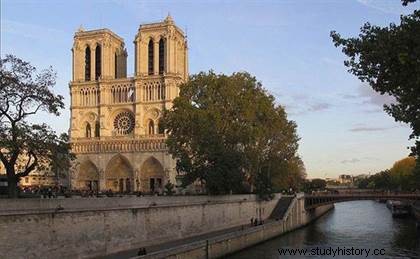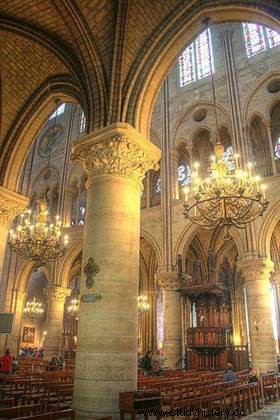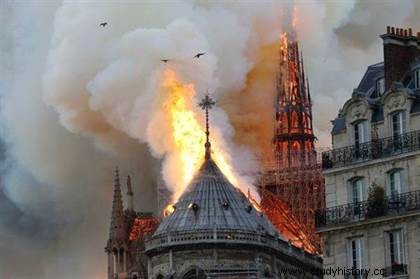 In 2013, Notre-Dame de Paris celebrated its 850th anniversary. Well rooted on the Île de la Cité for more than eight centuries, the cathedral is one of the most famous monuments of the capital and a privileged witness to the French history . Its construction lasted almost a century, not counting the modifications that followed, and in particular the controversial work of Viollet-le-Duc in the 19th century. It was the most visited historical monument in France until a terrible and spectacular fire ravage it on April 15, 2019 , causing shock all over the world.
In 2013, Notre-Dame de Paris celebrated its 850th anniversary. Well rooted on the Île de la Cité for more than eight centuries, the cathedral is one of the most famous monuments of the capital and a privileged witness to the French history . Its construction lasted almost a century, not counting the modifications that followed, and in particular the controversial work of Viollet-le-Duc in the 19th century. It was the most visited historical monument in France until a terrible and spectacular fire ravage it on April 15, 2019 , causing shock all over the world.
Notre Dame de Paris:a construction launched during the reign of Louis VII
The date of the laying of the first stone is 1163. We are then under the reign of Louis VII, known as the Younger, a Crusader king since he was from the Second Crusade (1146-1149), a bitter failure. Louis VII is also famous for having been the first husband of Eleanor of Aquitaine, before he repudiated her in 1152, and she remarried Henry II Plantagenet, future king of England (and with whom she would have Richard Cœur de Lion comme fils), the first act in a long series of wars between France and England. Finally, he is above all the father of the one who succeeded him in 1180, Philippe Auguste.
 In 1163, Louis VII was forty-three years old and was present during the laying of the first stone of the cathedral, in the company of Pope Alexander III. The latter has just excommunicated Frédéric Barberousse, and is on the run in France. The context of the construction of Notre-Dame is therefore relatively troubled.
In 1163, Louis VII was forty-three years old and was present during the laying of the first stone of the cathedral, in the company of Pope Alexander III. The latter has just excommunicated Frédéric Barberousse, and is on the run in France. The context of the construction of Notre-Dame is therefore relatively troubled.
The great initiator of the construction of the cathedral remains, however, Bishop Maurice de Sully . Of modest origins, he was trained at the abbey of Fleury and did part of his studies in Paris, where he met the future king. He will baptize his son Philippe (Auguste). In 1160, Maurice de Sully was elected bishop of Paris, and only waited three years before launching his great project.
Notre Dame de Paris, the story of a Gothic cathedral...
The Bishop of Paris wants to replace Saint-Etienne Cathedral with a new building dedicated to the Virgin Mary, drawing inspiration from the new churches, called much later (and from pejorative way) "Gothic", which were the abbey church of Saint-Denis and the cathedrals of Noyon, Senlis, Laon and Sens. At the time, the bishopric of Paris also depended on the archbishopric of Sens. Maurice de Sully believes that Paris must have a cathedral on a par with other major episcopal cities. He takes advantage of the support of the king to carry out his project.
...completed under Saint Louis
Building such a building is no small feat. The construction site is gigantic, and it lasts nearly a century , seeing several sovereigns pass by:Louis VII therefore, Philippe Auguste, Louis VIII, and finally Louis IX, known as Saint Louis.
The construction took place in four stages:between 1162 and 1182, the choir and the double ambulatory; between 1182 and 1190, the last three bays of the nave, the aisles and the galleries; between 1190 and 1225, the foundations of the facade and the first two bays of the nave, plus the connection of the two bays to the high facade up to the gallery of the kings. Finally, from 1225 to 1250, the high gallery and the two facade towers and different arrangements of the high windows and the side chapels.
At this time, the cathedral is considered complete, but it experiences further modifications until the middle of the 14th century. Then comes the modern era, during which Gothic art is no longer in fashion...
Notre-Dame, between turmoil and renovation
In the 17th century, the cathedral underwent some minor modifications, except for the stained glass windows:those from the Middle Ages were replaced by white panes by the Le Vieil brothers...
During the revolutionary period, Notre-Dame obviously experienced the same setbacks as many religious buildings:the 13th century spire was dismantled and the statues of the gallery of kings were all destroyed, like those of the portals (with the exception of the Virgin). It also serves as a warehouse.
 At the beginning of the 19th century, driven by his reconciliation with the Church, Napoleon Bonaparte returned the cathedral to Catholic worship and was crowned emperor there in 1804. However, the building remains in a sorry state, including when it inspired Victor Hugo for his novel Notre-Dame de Paris (1831). It was the beginning of the renaissance for the cathedral:in 1844, the government of Louis-Philippe decided to restore it.
At the beginning of the 19th century, driven by his reconciliation with the Church, Napoleon Bonaparte returned the cathedral to Catholic worship and was crowned emperor there in 1804. However, the building remains in a sorry state, including when it inspired Victor Hugo for his novel Notre-Dame de Paris (1831). It was the beginning of the renaissance for the cathedral:in 1844, the government of Louis-Philippe decided to restore it.
The main architect in charge of the project is Eugène Viollet-le-Duc . His work was completed in 1864, and remains partly controversial for certain liberties he took, in particular the chimeras (or gargoyles) at the top of the facade, straight out of his imagination. The forecourt, meanwhile, was cleared by the work of Baron Haussmann .
The existence of Notre-Dame in the 20th century is calmer. It passed the two world wars without incident, and witnessed many historical events, from the Te Deum given at the Liberation to the funeral of François Mitterrand. The main renovation event was the renewal of the stained glass windows in the 1960s. In the 21st century, Notre-Dame de Paris cathedral is quite simply the most visited monument in France, ahead of the Eiffel Tower or the Louvre, with nearly fifteen million visitors (pilgrims and tourists) per year.
The fire of Notre-Dame de Paris in 2019
 April 15, 2019 around 6:50 p.m., a gigantic fire ravaged the cathedral of notre dame de paris while renovation work was in progress in the attic. It provokes immense emotion in France and around the world. The damage is considerable. The framework is destroyed, the spire of the cathedral has collapsed and many treasures and works of art have gone up in smoke. Its reconstruction will undoubtedly take several decades, and already mobilizes more than 250 researchers, historians, curators, archaeologists, anthropologists and chemists.
April 15, 2019 around 6:50 p.m., a gigantic fire ravaged the cathedral of notre dame de paris while renovation work was in progress in the attic. It provokes immense emotion in France and around the world. The damage is considerable. The framework is destroyed, the spire of the cathedral has collapsed and many treasures and works of art have gone up in smoke. Its reconstruction will undoubtedly take several decades, and already mobilizes more than 250 researchers, historians, curators, archaeologists, anthropologists and chemists.
The site of Notre-Dame Cathedral in Paris.
